Wyoming is a fossil hunter’s paradise! In fact, did you know that the setting for Disney’s 2015 film The Good Dinosaur was based on the landscape of Wyoming? This incredible state was once home to fish, dinosaurs, birds, and even megafauna mammals during the Paleozoic, Mesozoic, and Cenozoic eras. Sediments here have been geologically active for over 500 million years, so who knows what else is just waiting to be uncovered! With fossils from millions of years ago, museums from all over come here looking for dinosaurs and other prehistoric creatures. Let’s take a closer look at 10 dinosaurs in Wyoming, and where you can see fossils in the state today!
1. Apatosaurus
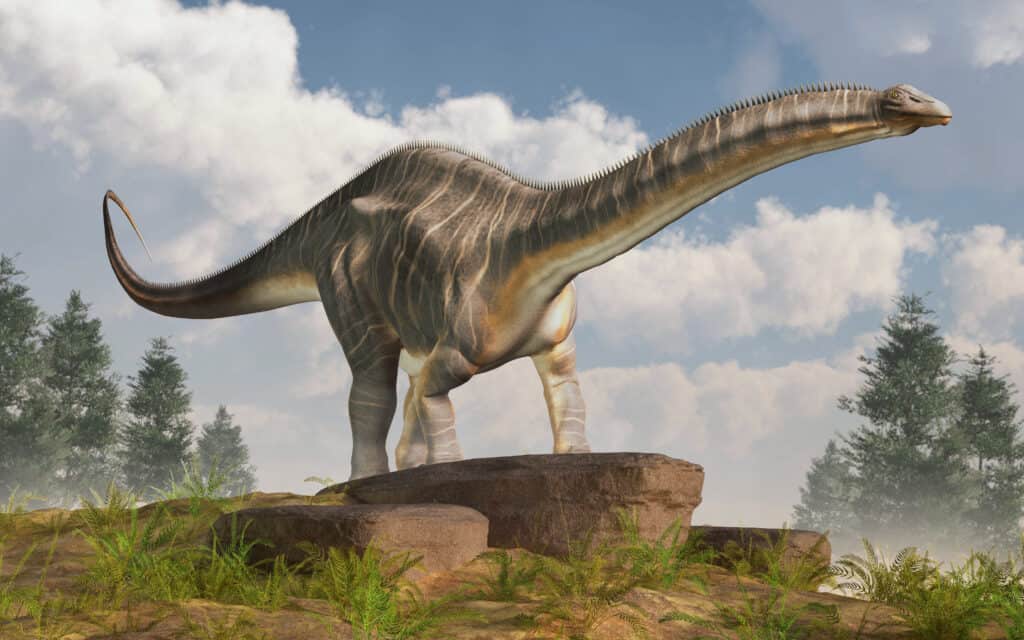
The Apatosaurus was one of the biggest land animals ever seen.
©Daniel Eskridge/Shutterstock.com
The Apatosaurus was one of the biggest, most famous plant-eating dinosaurs from the Jurassic period! If you don’t recognize its name, that’s because for a long time, people mistakenly called this dinosaur a brontosaurus. The Apatosaurus was one of the biggest land animals ever seen. They could reach heights of 15 feet at the hips and lengths up to 70 feet. On top of that, these giants weighed up to 40 tons! They were herbivores and would have enjoyed noshing on plants like horsetail ferns and leaves from trees.
2. Baptanodon
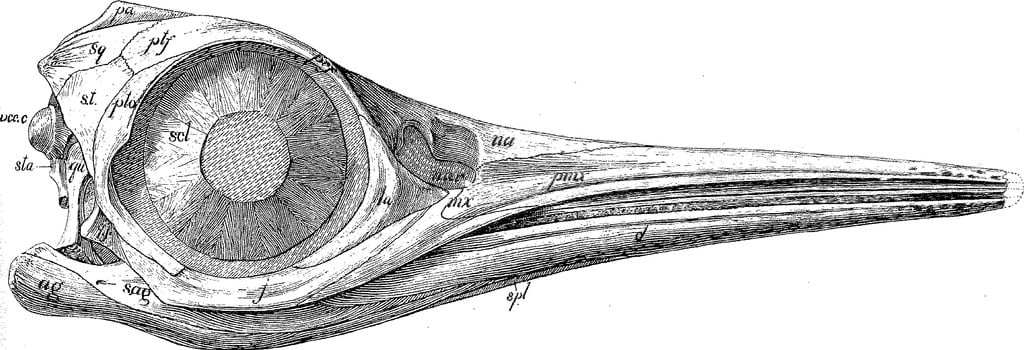
©Some artist working for C. W. Gilmore / public domain – License
Around 160 to 156 million years ago, during the Late Jurassic period, the middle of North America was filled with salt water called the Sundance Sea. And swimming in these deep waters was the baptanodon — a giant creature that measured 20 feet long and had ginormous eyes! The baptanodon’s graceful body was 11 feet long with a dolphin shape, while its jaws were perfect for catching squid. Fossils from this prehistoric creature have been found in the marine beds of Wyoming’s Oxfordian-Age Sundance Formation.
3. Stegosaurus

The stegosaurus is a plant-eating dinosaur.
©Daniel Eskridge/Shutterstock.com
One of the most complete stegosaurus skeletons ever found was uncovered in Wyoming! In 2003, professional fossil hunter Bob Simon uncovered the dinosaur’s skeleton at Red Canyon Ranch in Wyoming. Nicknamed “Sophie,” this stegosaurus fossil is extra special due to how well-preserved it is. It has been instrumental for scientists as they learn more about its biology and prehistoric life.
Unlike most other skeletons, Sophie was complete and was even preserved in three dimensions. This gave us an accurate view of how the whole body of the stegosaurus once looked. Sophie lived around 150 million years ago during the Jurassic period. She was a plant-eating dinosaur that munched on things like ferns and tough vegetation.
4. Megalneusaurus

©ДиБгд at Russian Wikipedia, Public domain, via Wikimedia Commons – License
The megalneusaurus existed in the Late Jurassic, approximately 156 to 152 million years ago. It was a large pliosaur that live in the warm waters of the Sundance Sea. In 1895, evidence of ribs, vertebrae, a fore-paddle, and fragments of the pectoral girdle were discovered in Wyoming’s Sundance Formation. The megalneusaurus was a large creature, believed to be between 25 and 30 feet in length. However, some scientists think it could have been up to 36 feet in size!
5. Serpentisuchops

How would you like the nickname “snaky croc-face?” Well, that’s exactly what Serpentisuchops pfisterae means! This unique dinosaur was discovered back in 1995, but it wasn’t identified and given an official name until 2022.
Millions of years ago, this large, 23-foot-long reptile moved through the water of an ancient sea in Wyoming. Its long neck swayed back and forth as it used its crocodile-like mouth to catch fish and other small sea creatures. Usually, plesiosaurs come in two kinds — ones with a long, snake-like neck and small head, or ones with short necks and long crocodile-like jaws. This creature however was weird and unique — it was a combination of both!
6. Triceratops

Triceratops had a long bony frill with three horns on their skull.
©Dotted Yeti/Shutterstock.com
Wyoming’s official state dinosaur is the triceratops. In 2013, some of the most complete triceratops skeletons were found in Wyoming! It is believed that one of them was a child, and at least one was attacked by a fierce predator. These large horned dinosaurs lived in Wyoming over 65 million years ago during the Cretaceous Period. The triceratops’ intimidating horns and frill were for defense and display since this vegetarian was a peaceful creature.
7. Ankylosaurus

Ankylosaurus fossils have been found in Wyoming’s Ferris Formation and Lance Formation.
©Warpaint/Shutterstock.com
This armored herbivore was heavily built, with bony plates and a club-like tail used for defense. Researchers estimate that the ankylosaurus weighed up to 5 tons and was up to 24 feet long. Ankylosaurus fossils have been found in Wyoming’s Ferris Formation and Lance Formation. The skin of this amazing dinosaur had knobs and plates of bone, called osteoderms or scutes. These helped to protect this plant-eating dinosaur from predators.
8. Diplodocus
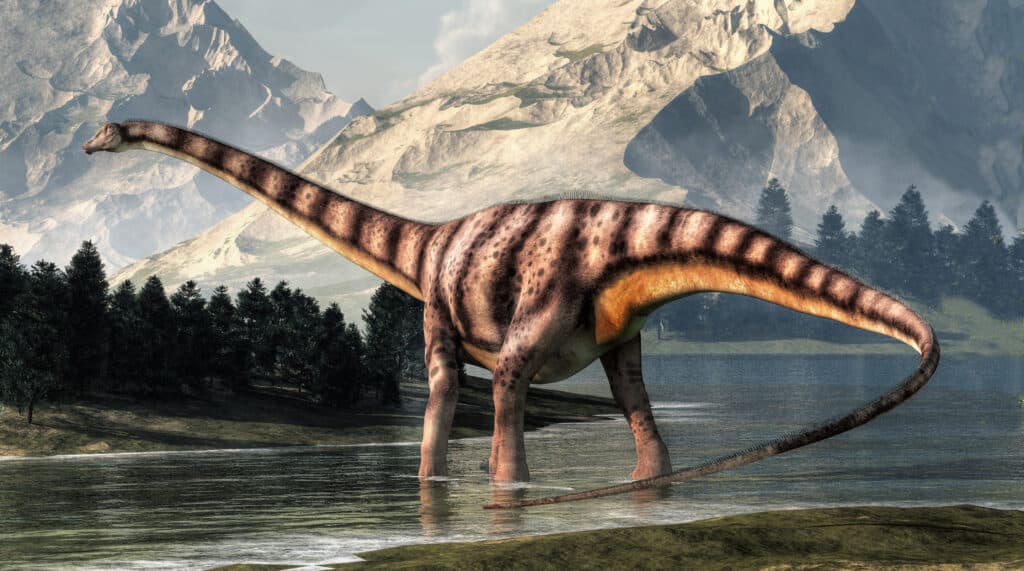
The
Diplodocus
was a long-necked and long-tailed sauropod that could grow up to 90 feet in length!
©Daniel Eskridge/Shutterstock.com
One of the most iconic dinosaurs from the Jurassic period was the diplodocus. It was an incredibly large creature, measuring up to 90 feet long and weighing around 22 tons! The diplodocus had a long neck with many vertebrae and a whip-like tail, which it used for balance as it walked on four legs. Its most iconic feature was its size, as it was one of the largest animals ever to walk the Earth.
On July 2, 1899, a huge diplodocus was uncovered in Wyoming at Sheep Creek. This discovery was sent to the Carnegie Museum of Pittsburgh and it became one of the most famous dinosaurs in history! Andrew Carnegie then paid to have copies of this dinosaur sent all around the world, introducing millions of people to dinosaurs and paleontology for the first time.
9. Pachycephalosaurus

Scientists think that the
pachycephalosaurus
was around 15 feet long and weighed about 820 to 990 pounds.
©Daniel Eskridge/Shutterstock.com
Pachycephalosaurus was a small- to medium-sized dinosaur with a thick, dome-shaped head. Its name actually means “thick-headed lizard” in Greek! The pachycephalosaurus used its thick skull to protect itself from predators. Pachycephalosaurus wyomingensis is the only officially valid species of pachycephalosaurus. It got its name from a skull found in the Lance Formation in Niobrara County, Wyoming.
Scientists think that the pachycephalosaurus was around 15 feet long and weighed about 820 to 990 pounds. This dinosaur had tiny, ridged teeth, so it wouldn’t have been able to chew tough plants like other dinosaurs from the same period. It likely ate leaves, seeds, fruits, and possibly meat.
10. Tyrannosaurus Rex

Most
tyrannosaurus rex
fossils found in Wyoming are sent to researchers and scientists around the world.
©iStock.com/chaiyapruek2520
The tyrannosaurus rex, or “T-Rex”, is one of the most iconic dinosaurs to ever live on earth, thanks to the many Hollywood depictions of this ferocious dinosaur. The Late Cretaceous period (90 to 66 million years ago) saw these giant predators roaming around what is now Wyoming.
Most tyrannosaurus rex fossils found in Wyoming are sent to researchers and scientists around the world. However, one special skeleton is still housed within the fossil-rich state, a tyrannosaurus rex named “Lee Rex.” J.P. Cavigelli, a museum field operations specialist working in eastern Wyoming, stumbled upon the first bone of Lee Rex’s skeleton in 2005 — when he was looking for a spot to take a bathroom break! Today, visitors can stop by the ordinary-looking garage next to the Tate Geological Museum at Casper College in Wyoming to see Lee Rex’s fossilized remains.
Where to See Fossils in Wyoming:
Wyoming is home to many incredible fossil finds, and it’s not hard to spot some if you know where to look. The state is famous for its dinosaur fossil discoveries, with numerous sites throughout the state that hold collections of fossils dating back millions of years. Here is our list of some of the best places to see fossils in Wyoming!
Museums with Fossils in Wyoming:
The University of Wyoming Geological Museum

©User:Cqfx / CC BY-SA 3.0, via Wikimedia Commons – License
Located in Laramie, the University of Wyoming Geological Museum showcases specimens from all around the world. Visitors can observe fossils of all shapes and sizes, from the 75-foot apatosaurus skeleton, to “Big Al”, the most complete allosaurus fossil ever found! The museum also houses mineral samples and rock collections. Visitors here can explore the colorful history of Wyoming’s unique environmental resources. The museum’s Prep Lab is a working exhibit where you can watch researchers in action and ask questions about the fossil preparation process.
Wyoming State Museum

©Smallbones / CC0 1.0, via Wikimedia Commons – License
At the Wyoming State Museum in Cheyenne, you can see the first dinosaur found in Wyoming! Part of the “R.I.P. – Rex in Pieces” exhibit, this camptosaurus is just one example of the many fossils on display. The museum also offers stories about Wyoming’s wildlife and human history, making it an essential destination for anyone looking to explore the region’s past. And if you visit the museum on its annual “Dino Day”, the museum grounds will be transformed into a dinosaur-themed wonderland! Kids can meet real paleontologists and learn about the science behind studying the ancient past.
Tate Geological Museum at Casper College
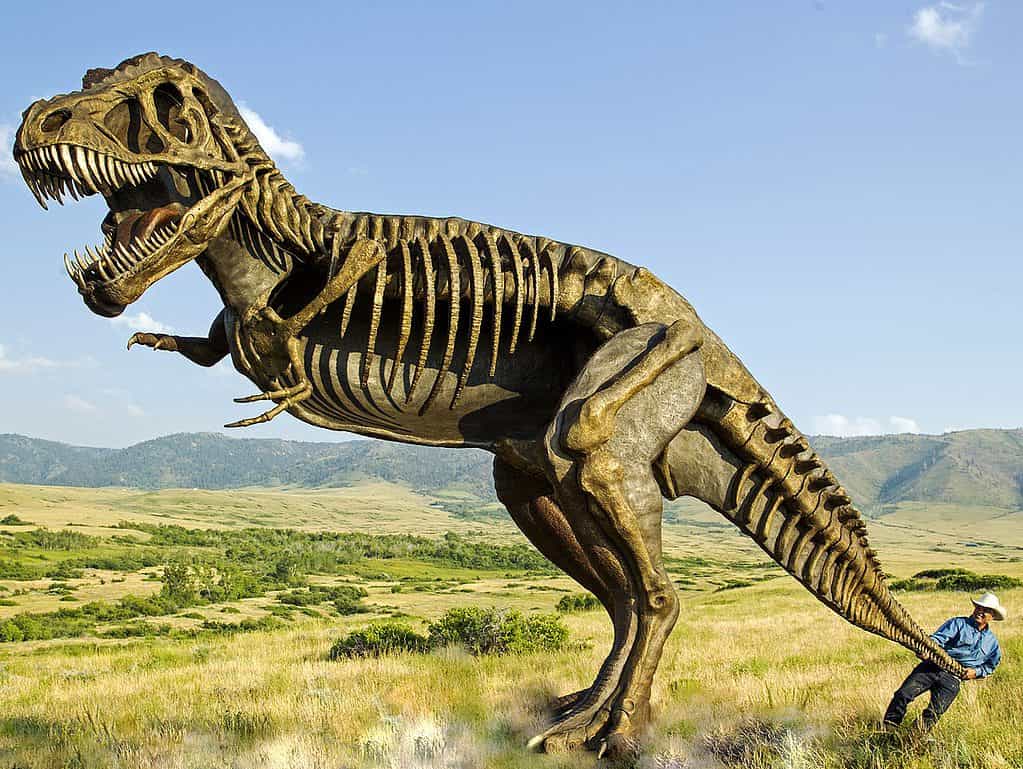
©Chris Navarro / CC BY-SA 4.0via, Wikimedia Commons – License
At the Tate Geological Museum at Casper College, visitors have the opportunity to see Wyoming’s famous tyrannosaurus rex, Lee Rex, and Dee, one of the largest Columbian mammoths ever found. For those who wish to dive even deeper into Wyoming’s past, there are weekly digs where visitors can uncover artifacts from long ago. Each summer, the museum also hosts Dinosaur Digs, where participants can spend a week uncovering and collecting artifacts from the ancient past.
Western Wyoming Community College Natural History Museum
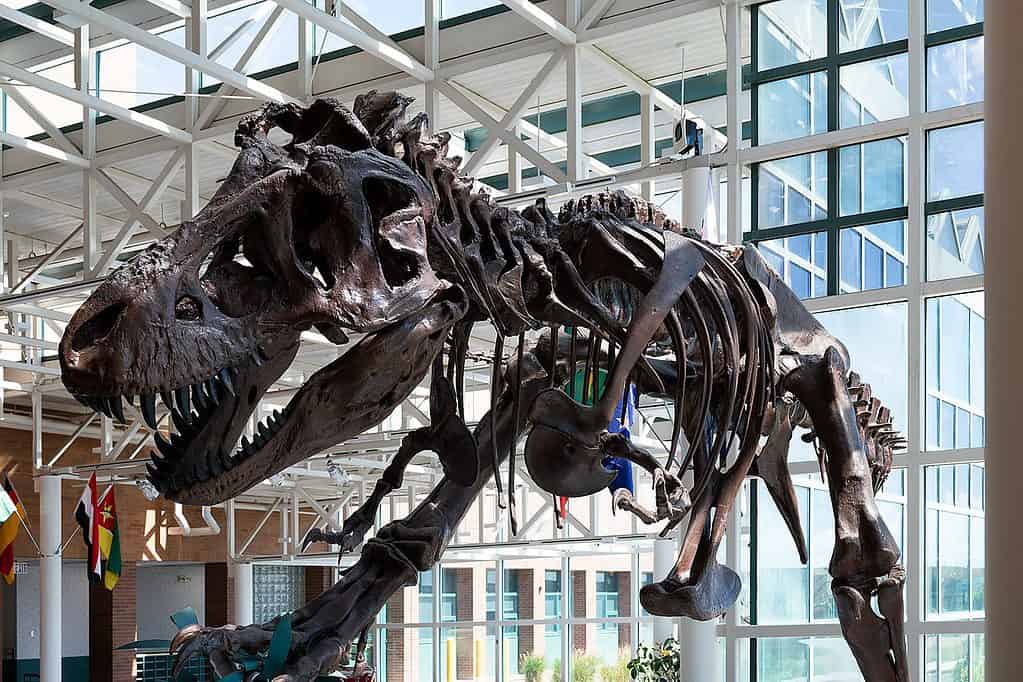
©KEmerson / CC BY-SA 4.0, via Wikimedia Commons – License
At the Western Wyoming Community College Natural History Museum in Rock Springs, visitors can get an up-close look at life-size dinosaur specimens, including triceratops, stegosaurus, and tyrannosaurus rex. In addition, they will discover fossils of fish, reptiles, and palm leaves as well as pottery and other artifacts that tell us something about Wyoming’s earliest inhabitants.
Washakie Museum and Cultural Center

Visitors to the Washakie Museum and Cultural Center can explore fossils of long-extinct creatures like deinonychus, an ancient Eocene
bird
.
©William Silver/Shutterstock.com
Also located in Worland, Wyoming, the Washakie Museum and Cultural Center is a unique destination for those interested in the history of the Big Horn Basin. Visitors can explore fossils of long-extinct creatures like deinonychus, an ancient Eocene bird, and carpolestes, one of the earliest primates known to walk this planet. With events every month and interactive activities focused on Native American culture and tradition, the museum provides a great way to learn about this region’s rich heritage.
Bighorn Basin Geoscience Center
Located in Greybull, Wyoming, the Bighorn Basin Geoscience Center is home to fossils that are millions of years old. The Geoscience Center there offers multi-day workshops where geoscientists teach the public about these fascinating creatures and their habitats. The museum also features a 40-foot mural painted by Michael Kopriva. It’s an amazing snapshot of how the landscape, flora, and fauna looked about 150 million years ago! Next to it is an incredible display of actual rocks, plants, and fallen trees designed by Lori from the Crazy Woman Trading Post across the street from the museum.
Greybull Museum
Visitors to the Greybull Museum can explore the incredible fossils of ammonites, which resemble squid but lived in coiled shells. These fossils range from small specimens to some that measure up to 5 feet in diameter! Along with the ammonite fossils, visitors can marvel at a wonderful collection of agates, tree sections, and other prehistoric relics. For those interested in more recent artifacts, there are also pieces of war memorabilia and Native American artifacts available to view and admire.
Paleon Museum
The Paleon Museum in Glenrock, Wyoming, is a unique and fascinating experience for anyone interested in natural history. With exhibits dedicated to fossils, minerals, and geology from millions of years ago it’s sure to be educational and entertaining. The museum holds an incredible collection of dinosaur remains and fossils from the Jurassic and Cretaceous periods found in Wyoming. There is also a preparation lab where volunteers are on hand to explain the bones they are working on.
Wyoming Dinosaur Center

©charkes / CC BY-SA 3.0, via Wikimedia Commons – License
Step into the past and become a paleontologist for a few hours at the Wyoming Dinosaur Center in Thermopolis. It offers interactive exhibits, educational workshops, and activities for all ages, making it perfect for everyone from school groups to families. You can even experience history firsthand with their “Dig for a Day” program, giving you a chance to discover fossils and uncover dinosaur bones that have been buried for millions of years. And when you’re done, you can even take home a souvenir from your prehistoric adventure!
Outdoor Trails and Track Sites with Fossils in Wyoming:
Cottonwood Creek Dinosaur Trail
The Cottonwood Creek Dinosaur Trail in Alcova, Wyoming, is a fascinating glimpse into the distant past. Managed by the Bureau of Reclamation, this 3.2-mile-long trail gives hikers a glimpse into Wyoming’s geological evolution. Along the route, visitors will find interpretive signs that explain significant discoveries about the environment and its inhabitants during the Late Triassic and Early Jurassic periods. Additionally, some of these amazing fossils can still be found in their natural settings!
Red Gulch Dinosaur Tracksite

©Bureau of Land Management / CC BY 2.0 – License
The Red Gulch Dinosaur Tracksite located in Worland, Wyoming, is one of the few tracksites from the Middle Jurassic Period, around 160 to 180 million years ago. Here you’ll find hundreds of dinosaur tracks, and it’s thought that many more might remain hidden beneath the 40-acre area. Evidence shows that these footprints were left onshore rather than in deep ocean water. This suggests there was ample dry land present to sustain not only dinosaurs but other animals and plants too!
Fossil Butte National Monument
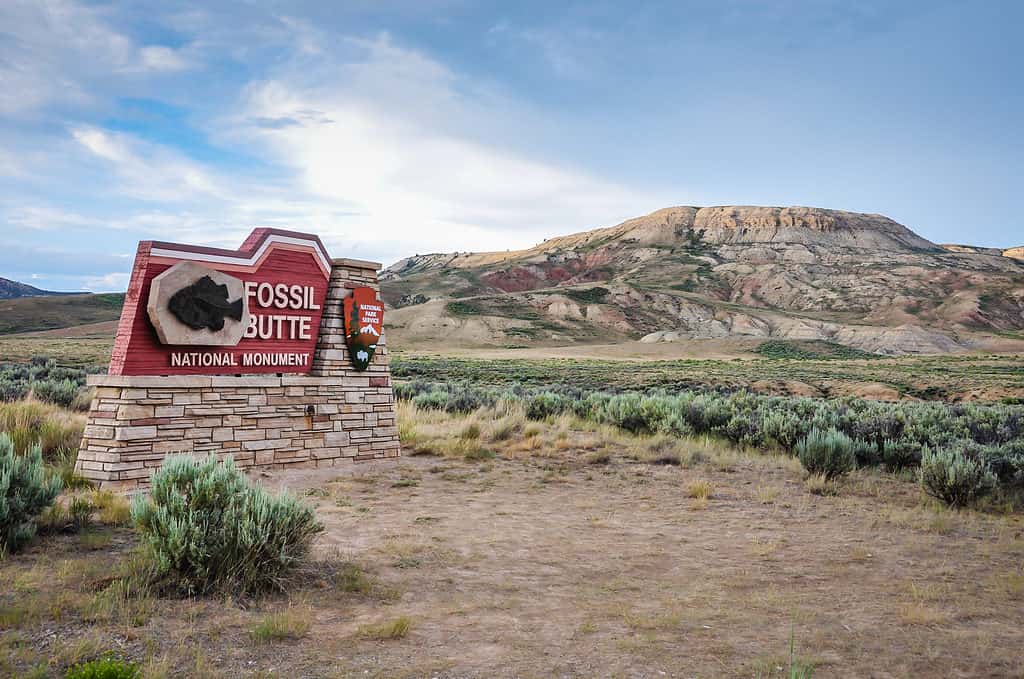
Fossil Butte National Monument is home to thousands of fossils, and visitors can explore the park’s diverse landscapes.
©Sandra Foyt/Shutterstock.com
This Monument is a unique and beautiful area located in southwestern Wyoming. It is home to thousands of fossils, and visitors can explore the park’s diverse landscapes such as badlands and riparian zones, or learn more about the local flora and fauna. Along with its natural wonders, Fossil Butte also offers activities such as fishing, camping, hiking, and wildlife viewing opportunities.
Where to Dig For Your Own Fossils in Wyoming:
Paleo Park
Nestled in the Wyoming countryside, just thirty miles south of Newcastle, lies a small ranch that has now become a hotspot for paleontologists and dinosaur enthusiasts. This unique spot, now known as Paleo Park, is home to an abundance of fossils from the Cretaceous period, with some of the most incredible discoveries ever seen! Even today, scientists and dinosaur hunters alike still unearth amazing relics at Paleo Park.
That’s right — you can dig for your very own fossils here! Fossils, bones, footprints, and teeth can all be found at Paleo Park with just a bit of searching. Some of them don’t even require digging! The management reserves the right to keep some of the finds. However, they also allow guests to take home a few as a special memento of their adventure in the past.
Bliss Dinosaur Ranch
With 3,500 acres full of prehistoric creatures in the Hell Creek Formation, visitors to the Bliss Dinosaur Ranch can uncover any number of 300 different species! Most hunters go home with teeth or bones that they discovered themselves. Be sure to check out the ranch’s photos and collection of fossils found on-site before you start your adventure! Bliss Dinosaur Ranch is located in Biddle, Wyoming, around 50 miles north of Gillette,
Ulrich’s Fossil Gallery
At Ulrich’s Fossil Gallery in Kemmerer, Wyoming, visitors can explore a stunning collection of fossilized dinosaur bones, fish fossils, and other unique specimens. You can also go on a guided fossil dig tour in the Green River Formation, where you’re sure to find a unique souvenir to take home with you!
Warfield Fossil Safari
Not too far from Fossil Butte Monument, you can join in an actual fossil safari! On a tour of this private quarry at Warfield Springs, visitors can uncover well-preserved ancient specimens that are 40 and 60 million years old from the Green River Foundation. In addition to the Warfield Fossil Safari, budding paleontologists can even bring home some of the ancient fish they find to start their own collection!
American Fossil
From May through September, you can visit American Fossil near Kemmerer, Wyoming, and dig for your very own fossils! Here you can explore the Green River Formation and dig up fossils — from turtles, fish, stingrays, crocodiles, and turtles, to insects, birds, and even ancient mammals! Pick out your favorite finds to take home or choose from the fossils other visitors have uncovered.
Tynsky’s Fossil Fish
Head over to Tynsky’s Fossil Fish near Fossil Butte National Monument where you can join the dig and mine your own fossils! You could uncover rare fossils, such as Diplomystus — a fish with an upturned mouth — or Priscacara, an ancestor of perch with a sunfish-like body.
Millions of years ago, this area was home to an ancient lake called Fossil Lake. The strange chemistry of Fossil Lake kept dead aquatic creatures from decaying or getting eaten by scavengers and allowed layers of limestone and organic matter to build up over time. Now fossilized, these layers contain the most fossilized fish found in any one place — more than anywhere else in the world! In fact, many of the ancient species found in these fossils are brand new and have never been seen before!
Up Next:
- Animals in Wyoming
- Discover the 7 Best National Parks in Wyoming
- What Were the Largest Flying Dinosaurs?
- Discover the 8 Smartest Dinosaurs Ever to Live — See Where T-Rex Ranks
The photo featured at the top of this post is © charkes / CC BY-SA 3.0, via Wikimedia Commons – License / Original
FAQs (Frequently Asked Questions)
What Disney movie was based on the Wyoming landscape?
Wyoming is a fossil hunter’s paradise! In fact, did you know that the setting for Disney’s 2015 film The Good Dinosaur was based on the landscape of Wyoming?
Who was Sophie?
In 2003, professional fossil hunter Bob Simon uncovered the dinosaur’s skeleton at Red Canyon Ranch in Wyoming. Nicknamed “Sophie,” this stegosaurus fossil is extra special due to how well-preserved it is. It has been instrumental for scientists as they learn more about its biology and prehistoric life
Thank you for reading! Have some feedback for us? Contact the AZ Animals editorial team.






